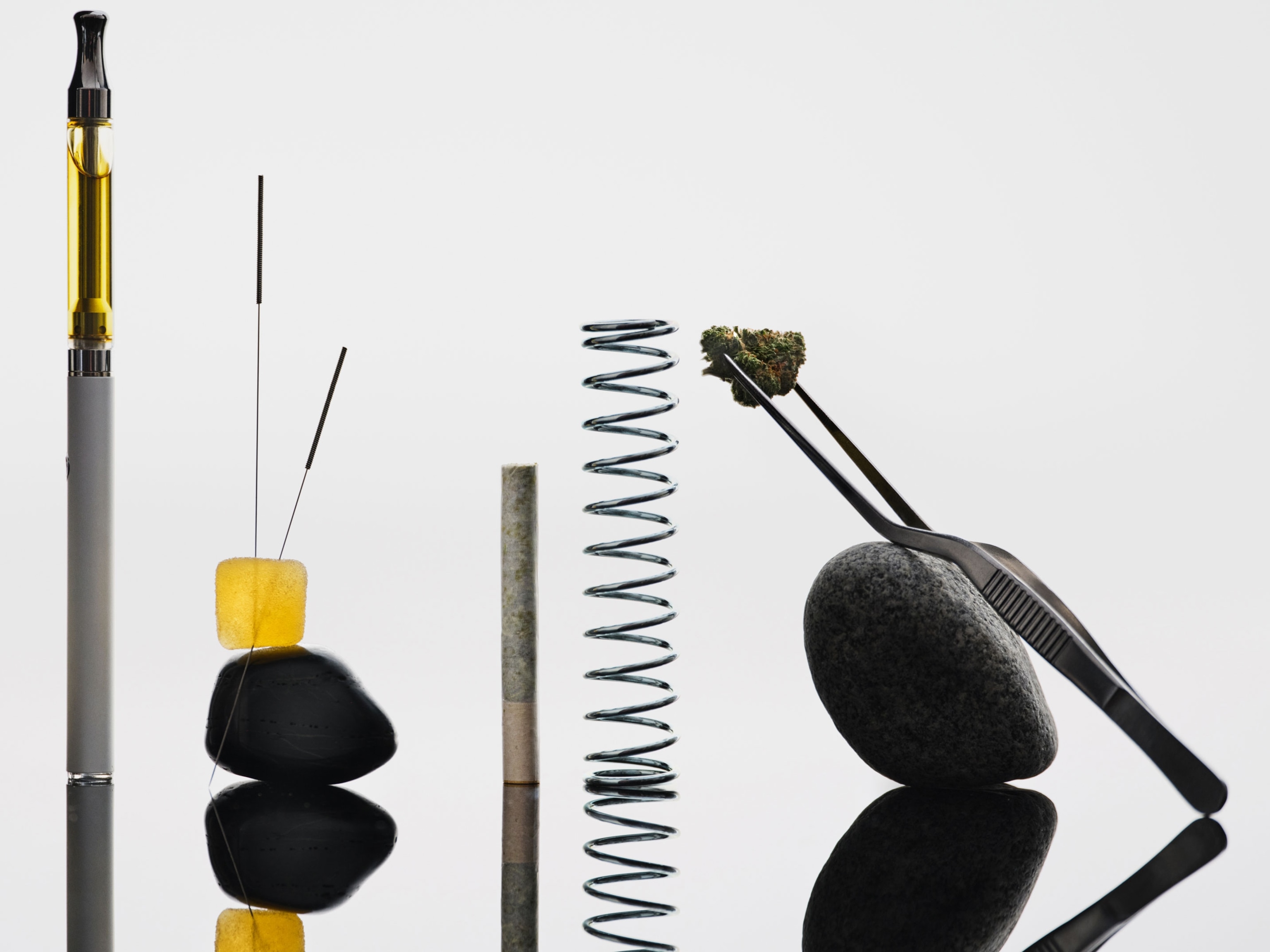This article is part of The New Cannabis, a National Geographic exploration into the most critical questions raised by today’s stronger, stranger, ever more accessible weed. Learn more.
In a white-walled lab inside the vast manufacturing facility of California cannabis company Raw Garden, the bouquet of marijuana is unmistakable, even without a plant or bud in sight. Technicians in lab coats monitor armoire-size machines that rattle as they refine flask after multi-liter flask of amber-colored, cannabis-scented oil. In a room around the corner, near a row of vacuum ovens, the same extracted oil has been used to make an array of concoctions set out on steel tables in trays, jars, and Pyrex dishes.
They range from viscous semiliquids that ooze like tree sap to creamy pastes resembling peanut butter. A few trays contain glasslike golden shards, and there’s a crystallizing substance akin to aging honey. Together the products represent a substantial shift in how Americans consume pot: Year after year, they are smoking proportionately less of it and instead embracing more products made with its extracted oil. These include edibles, like gummies and beverages, but also new types of high-potency concentrates that are consumed, not by smoking, but by vaping or what’s known as dabbing—flash vaporizing dabs of thick extract. And these concentrates are radically altering the experience of getting high.
Like other modern cannabis companies, Raw Garden still grows weed, but it is primarily a raw material, something to be processed into goop for an arguably heightened experience. If you think the heart of the United States’ roughly $32 billion cannabis industry looks like a farm or a grow room, think again: It increasingly looks like these industrial chem labs, full of scientists imagining new frontiers of mind-blowing offerings.
Such cannabis concentrates are often named for their textures: sauce, wax, shatter, diamonds, and more. They are dizzyingly more potent than the joint you might have smoked 20 or 40 years ago. And, of course, they are now legal in many states, as policy shifts have helped launch a space race in the cannabis industry, with entrepreneurs developing more sophisticated techniques to alchemize plant matter into a kaleidoscope of forms and flavors.
The rise of the high-potency concentrates market comes at a time when marijuana flower—traditional smokable cannabis—is already pretty darn powerful. Thanks to advances in crop science, pot grown in the U.S. has been bred to be substantially stronger than it was a few decades back. Potency in cannabis products is typically expressed as a concentration of delta-9-tetrahydrocannabinol, or THC, the compound in marijuana that is primarily, though not exclusively, responsible for its psychoactive effects. While precise numbers are tricky to come by, studies suggest that THC levels in marijuana sold in the U.S. 30 years ago averaged somewhere in the single digits. Today, at a time when many states require lab-verified potency labels on legal products, the average is somewhere between 15 and 20 percent.
Cannabis concentrates, however, result from an extraction process that isolates only the desired compounds, prominently including THC, from pesky plant matter. Raw Garden advertises a product called live sauce—a golden goo described as having an applesauce consistency—at around 70 percent THC potency, depending on the strain used to make it. The company’s refined live resin diamonds, which look like something you’d find at a gem show, can top out above 85 percent.
For some, the THC content—and hence, the rapidity and intensity of the buzz—is the point. High-potency vapes and dabs get users high with smaller amounts than other means of ingesting cannabis. But the draw also has to do with the subtlety of flavors and precision of one’s intake, says Raw Garden chief brand officer Dmitri Siegel. It’s “a purity thing,” he says, “where you’re either getting a really distilled high or you’re getting a really distilled flavor. You’re not burning a whole lot of organic matter.”

The many manifestations of modern cannabis include (left to right) cartridges of vape oil, gummy candies of varying potency, pre-rolled joints sold like cigarettes, and the buds the industry calls “flower.”
Handheld vaporizers are also less conspicuous, notes cannabis-industry analyst and consultant Tom Adams, president of Adams Research. Some concentrate users are enticed by the discreetness of taking a quick toke off a small amount of oil or applesauce-like gel. “It just seems odd as an adult to be taking weed out of a bag, crushing it up, and rolling it,” he says. “What am I, a cowboy?”
Adams, who has analyzed the legal cannabis market since 2015, says demand for legal concentrates originated in the first medical dispensaries. Smoking can be impractical for those looking to consume hundreds of milligrams of THC each day—a substantial amount, but which may nonetheless be what brings relief to chemotherapy patients or sufferers of chronic pain. Edibles can pose problems for patients with appetite or gastrointestinal issues.
And concentrates, whether for medical or recreational use, arguably make it easier to regulate dosage. Sure, Adams allows, pre-rolled joints, with measured amounts of flower, offer some consistency. “But even that is less predictable than the cleaned-up, scientifically produced concentrate that you know exactly what the impact is going to be,” he says. Rolling your own? Stuffing erratic hunks of vegetable matter into a pipe? It’s a hard sell, says Adams: “Consumers are just not used to the primitiveness.”
The quest to concentrate the psychoactive components of cannabis goes back to at least the 11th century, when hashish caught on recreationally in the Arab world. Hashish is made from plant glands now known as trichomes, which early hashmakers rubbed or sieved off the surface of cannabis leaves and buds, then pressed into a sort of cake. Trichomes are rich in bioactive compounds called cannabinoids, the most well known of which are THC and cannabidiol, or CBD. They also contain other specialized compounds, such as terpenes, the hydrocarbons responsible for plants’ aromas and flavors.
Today’s cannabis processors have built on medieval methods, finding new, efficient ways to isolate those prized compounds. Among the most common is hydrocarbon extraction, in which a solvent separates desired chemicals from raw plant material. Butane and propane are the industry-standard solvents, and prior to widespread legalization, back when extraction was an underground hobby, use of these combustible materials occasionally resulted in hotel rooms and apartments blowing up. FEMA went so far as to issue a bulletin in 2013 warning, “Hash Oil Explosions Increasing Across U.S.”
But during the wave of state legalization that has swept the country since, cannabis extraction has gone mainstream, and today companies like Raw Garden are subject to licensure, regulations, and inspections.
The basis of nearly all Raw Garden products is the oily substance known as live resin, a cannabis extract that aims to capture a wide array of those cannabinoids and terpenes (some extraction processes, by contrast, isolate only a single compound—usually THC or CBD). But before they become oil, all of the company’s offerings start out as plants on 54 acres of farmland in the Santa Barbara wine country. At harvest time, the plants are cut, then the buds are removed and immediately flash frozen with liquid nitrogen in a cryogenic tunnel, preserving all those volatile organic compounds.
You May Also Like
From the farm, the pot is trucked to a cold-storage warehouse in nearby Lompoc, where it’s placed in a deep freeze. When any given strain is up for extraction, the frozen buds are moved to a manufacturing facility up the road, where they’re loaded into six-foot-tall stainless steel columns, each of which can hold about 18 pounds of pot. Inside, they’re saturated with pressurized solvent that dissolves the desired chemicals and leaves behind unwanted biomass.
Later stages for some products include one in which the crude extract is purified, with fats, waxes, lipids, and other solids filtered out. Other products cook for 24 to 36 hours in a vacuum oven to purge away residual solvent, the pressure inside the oven lowered so that the solvent evaporates without any of the good stuff boiling off.
Using solvents isn’t the only way to make an extract. Raw Garden sends a small amount of its harvest to a partner facility, where it’s turned into a hashish-like product called rosin via a simpler process, using only ice water, heat, and pressure. But hydrocarbon extraction is scalable and highly efficient: Raw Garden’s facility processes around 1,200 pounds of cannabis a day, and has plans to expand.
This isn’t to say there’s no art to it. A concentrate’s consistency—that is, whether the live resin turns into something creamy or crispy or oily—results from the strain one starts with, as well as small, inspired interventions during extraction. What if we whipped the extract before purging it? What if we cured it so that crystals form? Extract bound for vape cartridges sometimes involves an additional step, in which terpenes are evaporated and collected in a distillation column, then selectively reinserted to achieve specific scent and flavor profiles. In Raw Garden’s vape lab, a colorful aroma wheel shows a hundred-plus fragrances one might allegedly encounter in cannabis, like apricot, sage, pine tar, and espresso. “We’re taking aromatic compounds from plants,” says vice president of agricultural operations Casey Birthisel. “There’s a lot here that’s parallel to the perfume industry.”
Some medical professionals see more alarming parallels, however, to drugs ostensibly harder than cannabis. The sky-high potency of concentrates has raised red flags, as multiple epidemiological studies have found correlations between their frequent use and increased risks of psychosis and cannabis use disorder, a form of dependence. Those risks seem particularly acute for teenagers. Colorado and Washington, the first states to legalize recreational pot, are among the states where bills to limit THC potency have been introduced, then rejected or withdrawn amid industry pushback.
Meanwhile, according to analyst Adams, sales of marijuana flower made up about 70 percent of the recreational market when the first legal retailers opened in Colorado in 2014. Today, according to point-of-sale data from Adams and market research firm BDSA, that number has dropped to 40 percent. In the same span, sales of vaping and dabbing products have climbed from around 15 percent of the legal market to 32 percent, though the pace of that growth now seems to be slowing.
It’s all a function, Adams says, of a “reunion of technology and cannabis” brought about by legalization. Ironically, what excites him most about the future of extraction has nothing to do with THC. The next big thing in cannabis, Adams suggests, might derive from the industry’s ability to efficiently isolate all those other compounds. What new effects are there to discover from the terpenes? Or from the more than a hundred other little-researched cannabinoids that aren’t THC or CBD?
“We are totally revolutionizing the view of what the compounds in the plant can do through the concentrates side of the market,” he says. “That opens up the uses to all sorts of things other than sitting on the couch watching Netflix.”
This story appears in the September 2025 issue of National Geographic magazine.
Set Design: Mat Cullen, Lalaland Artists



